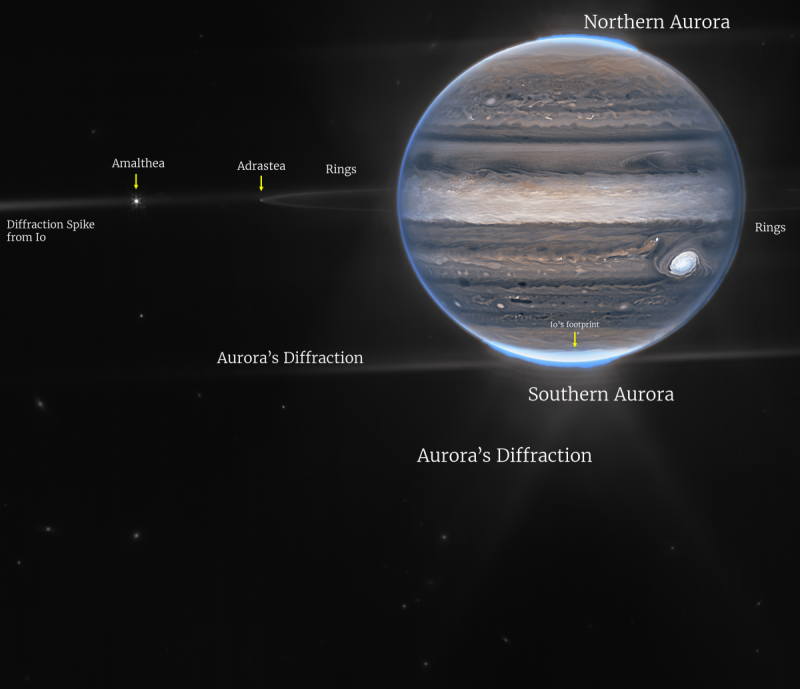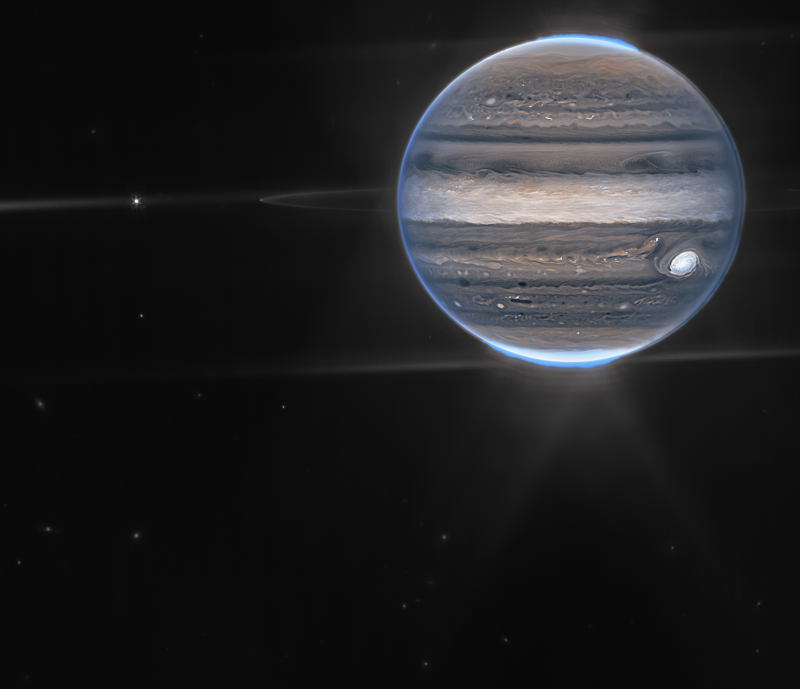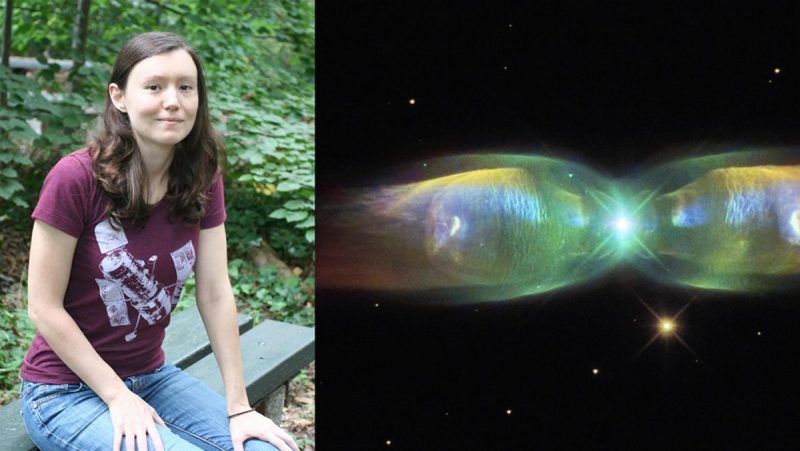
Jupiter from Webb in new images
Jupiter reveals amazing details in new images from NASA’s James Webb Space Telescope released today (August 22, 2022). With giant storms, powerful winds, auroras, and extreme temperature and pressure conditions, Jupiter has a lot going on. Webb’s Jupiter observations will give scientists even more clues to Jupiter’s inner life.
Imke de Pater, a planetary astronomer and professor emerita of the University of California, Berkeley, led the observations of Jupiter with Thierry Fouchet, a professor at the Paris Observatory. The Jupiter study is part of an international collaboration for Webb’s Early Release Science program. Webb itself is an international mission led by NASA with its partners ESA (European Space Agency) and CSA (Canadian Space Agency). De Pater said:
We hadn’t really expected it to be this good, to be honest. It’s really remarkable that we can see details on Jupiter together with its rings, tiny satellites, and even galaxies in one image.

Jupiter from Webb: Auroras
The images come from the observatory’s Near-Infrared Camera (NIRCam), which has three specialized infrared filters that showcase details of the planet. Since infrared light is invisible to the human eye, the light has been mapped onto the visible spectrum. Generally, the longest wavelengths appear redder and the shortest wavelengths are shown as bluer. After that, scientists collaborated with citizen scientist Judy Schmidt to translate the Webb data into images.
In the standalone view of Jupiter, created from a composite of several images from Webb, auroras extend to high altitudes above both the northern and southern poles of Jupiter. The auroras shine in a filter that is mapped to redder colors, which also highlights light reflected from lower clouds and upper hazes. A different filter, mapped to yellows and greens, shows hazes swirling around the northern and southern poles. Finally, a third filter, mapped to blues, highlights light reflected from a deeper main cloud.
Jupiter from Webb: Red Spot looks white
The Great Red Spot, a famous storm so big it could swallow Earth, appears white in these views, as do other clouds. That’s because, they are reflecting a lot of sunlight. By contrast, dark ribbons north of the equatorial region have little cloud cover.
Heidi Hammel, is a Webb interdisciplinary scientist for solar system observations and vice president for science at AURA. Hammel indicated:
The brightness here indicates high altitude, so the Great Red Spot has high-altitude hazes, as does the equatorial region. The numerous bright white spots and streaks are likely very high-altitude cloud tops of condensed convective storms.

Jupiter from Webb: Bands, faint rings, moons
A wide-field view showcases Jupiter in the upper right quadrant. The planet’s swirling horizontal stripes are in blues, browns, and cream. Electric blue auroras glow above Jupiter’s north and south poles. A white glow emanates out from the auroras. Also, along the planet’s equator, rings glow in a faint white and are a million times fainter than the planet. At the far-left edge of the rings, a moon appears as a tiny white dot. Then slightly further to the left, another moon glows with tiny white diffraction spikes. The rest of the image is the blackness of space. Additionally, the fuzzy spots in the lower background are likely galaxies photobombing this Jovian view.
Researchers have already begun analyzing Webb data to get new science results about our solar system’s largest planet. Fouchet said:
This one image sums up the science of our Jupiter system program, which studies the dynamics and chemistry of Jupiter itself, its rings, and its satellite system.
Processing Webb data
Data from telescopes like Webb doesn’t arrive on Earth neatly packaged. Instead, it contains information about the brightness of the light on Webb’s detectors. This information arrives at the Space Telescope Science Institute (STScI), Webb’s mission and science operations center, as raw data. STScI processes the data into calibrated files for scientific analysis and delivers it to MAST (the Mikulski Archive for Space Telescopes) for dissemination. Then, scientists translate that information into images like these during their research. While a team at STScI formally processes Webb images for official release, non-professional astronomers known as citizen scientists often dive into the public data archive to retrieve and process images, too.

Meet Judy Schmidt, citizen scientist
Judy Schmidt of Modesto California, a longtime image processor in the citizen science community, processed these new views of Jupiter. For the image that includes the tiny satellites, she collaborated with Ricardo Hueso, a co-investigator on these observations, who studies planetary atmospheres at the University of the Basque Country in Spain.
Schmidt has no formal educational background in astronomy. But 10 years ago, an ESA contest sparked her insatiable passion for image processing. The Hubble’s Hidden Treasures competition invited the public to find new gems in Hubble data. And out of nearly 3,000 submissions, Schmidt took home third place for an image of a newborn star.
Since the ESA contest, she has been working on Hubble and other telescope data as a hobby. Schmidt said:
Something about it just stuck with me, and I can’t stop. I could spend hours and hours every day.
Her love of astronomy images led her to process images of nebulae, globular clusters, stellar nurseries, and more spectacular cosmic objects. Overall, her guiding philosophy is to get them looking natural, even if it is not anything close to what your eye can see. Her images caught the attention of professional scientists, including Hammel, who previously collaborated with Schmidt on refining Hubble images of comet Shoemaker-Levy 9’s Jupiter impact.
The challenge of image processing
According to Schmidt, Jupiter is harder to work with than more distant cosmic wonders. That’s because of how fast Jupiter rotates. Plus combining a stack of images into one view can be challenging when Jupiter’s distinctive features have rotated during the time that the images were taken and are no longer aligned. Moreover, sometimes she needs to digitally make adjustments to stack the images in a way that makes sense.
As a matter of fact, Webb will deliver observations about every phase of cosmic history. However, if Schmidt had to pick one thing to be excited about, it would be more Webb views of star-forming regions. In particular, she is fascinated by young stars that produce powerful jets in small nebula patches called Herbig–Haro objects. She said:
I’m really looking forward to seeing these weird and wonderful baby stars blowing holes into nebulas.
Bottom line: New images of Jupiter from the James Webb Space Telescope’s show amazing details on the giant planet, including auroras, the Great Red Spot, and its rings and satellites.











